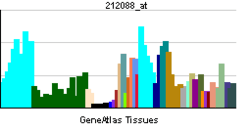PMPCA
| PMPCA | |||||||||||||||||
|---|---|---|---|---|---|---|---|---|---|---|---|---|---|---|---|---|---|
| Identifiers | |||||||||||||||||
| Aliases | PMPCA, Alpha-MPP, INPP5E, P-55, SCAR2, peptidase, mitochondrial processing alpha subunit | ||||||||||||||||
| External IDs | MGI: 1918568 HomoloGene: 6078 GeneCards: PMPCA | ||||||||||||||||
| |||||||||||||||||
| RNA expression pattern | |||||||||||||||||
 | |||||||||||||||||
| More reference expression data | |||||||||||||||||
| Orthologs | |||||||||||||||||
| Species | Human | Mouse | |||||||||||||||
| Entrez | |||||||||||||||||
| Ensembl | |||||||||||||||||
| UniProt | |||||||||||||||||
| RefSeq (mRNA) | |||||||||||||||||
| RefSeq (protein) | |||||||||||||||||
| Location (UCSC) | Chr 9: 136.41 – 136.42 Mb | Chr 2: 26.39 – 26.4 Mb | |||||||||||||||
| PubMed search | [1] | [2] | |||||||||||||||
| Wikidata | |||||||||||||||||
| View/Edit Human | View/Edit Mouse |
Mitochondrial-processing peptidase subunit alpha is an enzyme that in humans is encoded by the PMPCA gene.[3][4][5] This gene PMPCA encoded a protein that is a member of the peptidase M16 family. This protein is located in the mitochondrial matrix and catalyzes the cleavage of the leader peptides of precursor proteins newly imported into the mitochondria, though it only functions as part of a heterodimeric complex.
Structure
The Mitochondrial-processing peptidase subunit alpha precursor protein is 58.2 KDa in size and composed of 525 amino acids. The precursor protein contains a 33 amino acid N-terminal fragment as mitochondrion targeting sequence. After cleavage, the matured PMPCA protein is 54.6 KDa in size and has a theoretical pI of 5.88.
Function
Mitochondrial-processing peptidase (MPP) is a metalloendopeptidase, containing two structurally related subunits, Subunit alpha and mitochondrial-processing peptidase subunit beta, working in conjunction for its catalytic function.[6] Containing the catalytic site, the beta subunit PMPCB protein cleaves presequences (transit peptides) from mitochondrial protein precursors and releases of N-terminal transit peptides from precursor proteins imported into the mitochondrion, typically with Arg in position P2.
Interactions
As the alpha subunit of Mitochondrial-processing peptidase, PMPCA forms a heterodimer with the subunit PMPCB.
Clinical significance
The majority of mitochondrial proteins is nuclear-coded, which necessitates proper translocations of mitochondrial targeting proteins. Many mitochondrial proteins are synthesized in a precursor form that contains mitochondria targeting sequence. These precursors are usually cleaved by peptidases and proteases before they arrive their sub-organellar locations. It is likely that altered activity of the mitochondrial processing peptidases is essential to ensure the correct maturation of mitochondrial proteins and that altered activity of these proteases will have dramatic effects in the activity, stability and assembly of mitochondrial proteins. Evidences showed that MPP was involved in the proteolytic maturation of Frataxin, a protein responsible for iron homeostasis.[7] Accordingly, MPP deficiency was shown to be involved in Friedreich ataxia, an autossomic recessive neurodegenerative disorder[8][9]
References
- ↑ "Human PubMed Reference:".
- ↑ "Mouse PubMed Reference:".
- ↑ Nagase T, Seki N, Tanaka A, Ishikawa K, Nomura N (Mar 1996). "Prediction of the coding sequences of unidentified human genes. IV. The coding sequences of 40 new genes (KIAA0121-KIAA0160) deduced by analysis of cDNA clones from human cell line KG-1". DNA Res. 2 (4): 167–74, 199–210. doi:10.1093/dnares/2.4.167. PMID 8590280.
- ↑ Nagase T, Miyajima N, Tanaka A, Sazuka T, Seki N, Sato S, Tabata S, Ishikawa K, Kawarabayasi Y, Kotani H, et al. (Jul 1995). "Prediction of the coding sequences of unidentified human genes. III. The coding sequences of 40 new genes (KIAA0081-KIAA0120) deduced by analysis of cDNA clones from human cell line KG-1". DNA Res. 2 (1): 37–43. doi:10.1093/dnares/2.1.37. PMID 7788527.
- ↑ "Entrez Gene: PMPCA peptidase (mitochondrial processing) alpha".
- ↑ Teixeira PF, Glaser E (Feb 2013). "Processing peptidases in mitochondria and chloroplasts". Biochimica et Biophysica Acta. 1833 (2): 360–70. doi:10.1016/j.bbamcr.2012.03.012. PMID 22495024.
- ↑ Branda SS, Yang ZY, Chew A, Isaya G (Jun 1999). "Mitochondrial intermediate peptidase and the yeast frataxin homolog together maintain mitochondrial iron homeostasis in Saccharomyces cerevisiae". Human Molecular Genetics. 8 (6): 1099–110. doi:10.1093/hmg/8.6.1099. PMID 10332043.
- ↑ Cavadini P, Adamec J, Taroni F, Gakh O, Isaya G (Dec 2000). "Two-step processing of human frataxin by mitochondrial processing peptidase. Precursor and intermediate forms are cleaved at different rates". The Journal of Biological Chemistry. 275 (52): 41469–75. doi:10.1074/jbc.M006539200. PMID 11020385.
- ↑ Patel PI, Isaya G (Jul 2001). "Friedreich ataxia: from GAA triplet-repeat expansion to frataxin deficiency". American Journal of Human Genetics. 69 (1): 15–24. doi:10.1086/321283. PMID 11391483.
Further reading
- Srinivasan M, Kalousek F, Curthoys NP (1995). "In vitro characterization of the mitochondrial processing and the potential function of the 68-kDa subunit of renal glutaminase.". J. Biol. Chem. 270 (3): 1185–90. doi:10.1074/jbc.270.3.1185. PMID 7836378.
- Luciano P, Geoffroy S, Brandt A, et al. (1997). "Functional cooperation of the mitochondrial processing peptidase subunits.". J. Mol. Biol. 272 (2): 213–25. doi:10.1006/jmbi.1997.1231. PMID 9299349.
- Nagao Y, Kitada S, Kojima K, et al. (2000). "Glycine-rich region of mitochondrial processing peptidase alpha-subunit is essential for binding and cleavage of the precursor proteins.". J. Biol. Chem. 275 (44): 34552–6. doi:10.1074/jbc.M003110200. PMID 10942759.
- Harris RA, Yang A, Stein RC, et al. (2002). "Cluster analysis of an extensive human breast cancer cell line protein expression map database.". Proteomics. 2 (2): 212–23. doi:10.1002/1615-9861(200202)2:2<212::AID-PROT212>3.0.CO;2-H. PMID 11840567.
- Strausberg RL, Feingold EA, Grouse LH, et al. (2003). "Generation and initial analysis of more than 15,000 full-length human and mouse cDNA sequences.". Proc. Natl. Acad. Sci. U.S.A. 99 (26): 16899–903. doi:10.1073/pnas.242603899. PMC 139241
 . PMID 12477932.
. PMID 12477932. - Ota T, Suzuki Y, Nishikawa T, et al. (2004). "Complete sequencing and characterization of 21,243 full-length human cDNAs.". Nat. Genet. 36 (1): 40–5. doi:10.1038/ng1285. PMID 14702039.
- Hassel S, Eichner A, Yakymovych M, et al. (2004). "Proteins associated with type II bone morphogenetic protein receptor (BMPR-II) and identified by two-dimensional gel electrophoresis and mass spectrometry.". Proteomics. 4 (5): 1346–58. doi:10.1002/pmic.200300770. PMID 15188402.
- Gerhard DS, Wagner L, Feingold EA, et al. (2004). "The status, quality, and expansion of the NIH full-length cDNA project: the Mammalian Gene Collection (MGC).". Genome Res. 14 (10B): 2121–7. doi:10.1101/gr.2596504. PMC 528928
 . PMID 15489334.
. PMID 15489334.